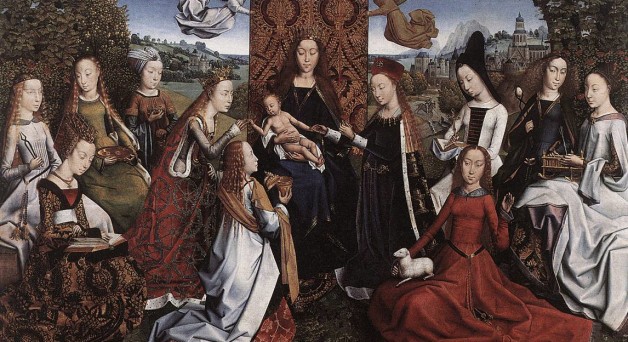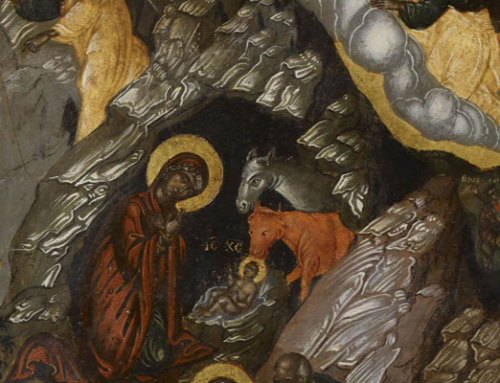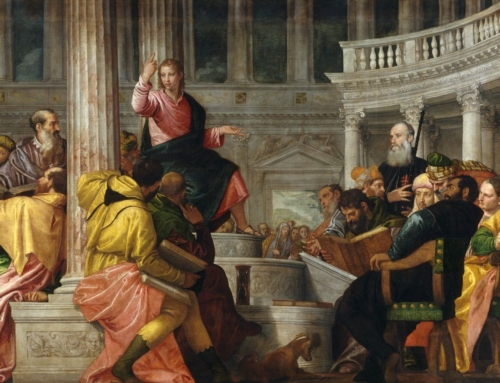In iconography, there are different tokens, called “attributes,” that help to distinguish between different saints. Attributes can be common objects, or more unusual ones. For example, St. Peter has a set of keys, St. Jerome is dressed as a cardinal (even though he wasn’t one), and St. Catherine of Alexandria is distinguished by a wheel.
Today is the feast of St. Lucy, which brings to mind the first time I saw an image of her, along with her “attribute.” She was holding two eyes, on a plate. No, that’s not a typo. Two eyes. On a plate.
In a word, it was grotesque. In several more words, it was unpalatable, impolite, bizarre, and disturbing. Of course, I wasn’t naïve enough to believe such things never happened—Byzantine history provides plenty of examples—but why would anyone be so crude as to commemorate it with a statue?
It’s said that, after St. Lucy was blinded, God miraculously restored her sight. But it’s also fairly likely that this is only a legend. After all, neither the blinding itself nor the miraculous healing is mentioned either in the thirteenth-century Golden Legend or in earlier works.
Perhaps it will be helpful to go to the Gospels:
The eye is the lamp of the body. So, if your eye is sound, your whole body will be full of light; but if your eye is not sound, your whole body will be full of darkness. If then the light in you is darkness, how great is the darkness! (Mt 6:22–23)
Christ points out the limits of our vision. In one way or another, we are all blinded to our faults. Incidentally, this passage comes right after Christ’s condemnation of hypocrisy. We can all look great in our own eyes, and we can all rationalize anything that gets in the way of our self-deception. But we have been warned, on good authority, not to embrace this way of seeing:
And if your eye causes you to sin, pluck it out and throw it away; it is better for you to enter life with one eye than with two eyes to be thrown into the hell of fire. (Mt 18:9)
And so, the unsettling image of St. Lucy starts to make a bit more sense. More than just a legendary accretion, her story is a call to the profound reevaluation we must make if we are to see clearly.
St. Lucy was martyred during the persecution of Diocletian, but, before she was killed, the Roman authorities tried to humiliate and disgrace her by condemning her to a house of ill repute—to put it more plainly, a brothel. When the judge sentenced her, she replied,
If you were to lift my hand to your idol and so make me offer against my will, I would still be guiltless in the sight of the true God, who judges according to the will and knows all things. If now, against my will, you cause me to be polluted, a twofold purity will be gloriously imputed to me. You cannot bend my will to your purpose; whatever you do to my body, that cannot happen to me.
St. Lucy could see something that the judge could not. But preaching the faith to him was like trying to sell the Brooklyn Bridge to a Manhattanite—a hard sell if there ever was one. His worldly way of thinking might be summed up in Mark Twain’s charming but cynical definition of faith: “believing that which we know not to be true.”
Charming, perhaps, but wrong—dead wrong. Such “faith” does not produce martyrs. St. Lucy, like other saints through the ages, saw through the outward appearance of respectability, comfort, and peace that is offered by the world. These items were off the table for her, because she caught the glimpse of something far greater.
Fulton Sheen once remarked that humor results from the ability to see through things. Slapstick, irony, even puns are only really funny when they point beyond themselves. The Church exhibits her sense of humor in this way by placing the feast day of St. Lucy, whose name means “light,” at the darkest time of the year. It’s not such a great one-liner, of course, and it won’t get as many laughs as Mark Twain. But then it’s a different kind of humor—the sort that doesn’t go stale.
C.S. Lewis gives his own charming description of faith in his second Narnia novel, Prince Caspian. One day, the youngest child in the story—Lucy Pevensie—encounters the lion Aslan, whom she hasn’t seen in a long time; but, much to her dismay, she soon realizes that her siblings cannot see him, even in broad daylight. Then she notices something else:
“Aslan,” said Lucy, “you’re bigger.”
“That is because you are older, little one,” answered he.
“Not because you are?”
“I am not. But every year you grow, you will find me bigger.”
As we grow older, does our faith, like the faith of St. Lucy and little Lucy Pevensie, allow us to see Christ “grow bigger”? Or is there a need to rub our eyes, in the event that we are missing something important? Getting to the bottom of these questions will probably take more than one Advent, so it’s a good idea to get started now.
✠
Image: Master of the Legend of St. Lucy, The Blessed Virgin Surrounded by Female Saints (For an identification of these saints and their attributes, go here.)







